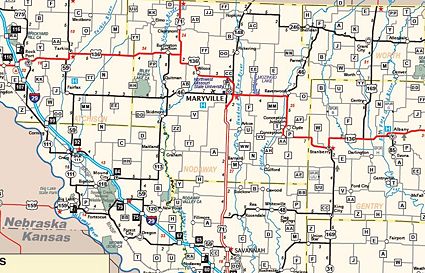Difference between revisions of "943.2 Route Marking Criteria"
m (article construction) |
m (updated figure) |
||
| Line 1: | Line 1: | ||
| − | [[image:943.2 | + | [[image:943.2 2013.jpg|right|425px]] |
'''943.2.1 Interstate Routes.''' Additions to the interstate system require [[943.3 AASHTO Policy on Route Marking and Application|approval by the FHWA and AASHTO]]. To be considered part of the interstate system the proposed section must be part of the National Highway System, be built to interstate standards, be a logical addition to the system and connect with an existing interstate route. | '''943.2.1 Interstate Routes.''' Additions to the interstate system require [[943.3 AASHTO Policy on Route Marking and Application|approval by the FHWA and AASHTO]]. To be considered part of the interstate system the proposed section must be part of the National Highway System, be built to interstate standards, be a logical addition to the system and connect with an existing interstate route. | ||
Latest revision as of 09:20, 4 September 2013
943.2.1 Interstate Routes. Additions to the interstate system require approval by the FHWA and AASHTO. To be considered part of the interstate system the proposed section must be part of the National Highway System, be built to interstate standards, be a logical addition to the system and connect with an existing interstate route.
943.2.2 U.S. Numbered Routes. The following requirements, as defined by AASHTO, must be met for a section of road to be considered for U.S. numbering:
- Meet Arterial Standards.
- Best and shortest route between major traffic generating areas.
- Must pass through two or more states.
- Must be a high percentage of through travel.
- No alternate marking be considered, unless it is comparable to the marked route, and both routes are needed to accommodate the travel.
- If the proposed alternate route is better than the marked route, and both are not needed for through travel, then the proposed alternate route should receive the U.S. marking.
943.2.3 State Numbered Routes. A state numbered route provides a more regional service than a U.S. numbered route. A set of guidelines has been developed:
- Be functionally classified as a minor arterial route or greater.
- Both ends should terminate at an arterial route (one end may terminate at a state line or at a state park).
- Have a minimum surface width of 24 ft.
- Provide a direct route between major destinations or serve recreation areas and/or population centers of 100 or more.
943.2.4 State Lettered Routes. These routes use a maximum of two letters. They are functionally classified as either a minor arterial or below and connect with other collector routes. State lettered routes are not to be a series of short segments marked as various lettered routes. They terminate at an arterial except
- When the lettered route designates a short connection between two arterials.
- When the lettered route designates a short connection between an arterial route and a recognized named community.
- When located within an incorporated area.
- When the grade separation does not have access to the arterial.

